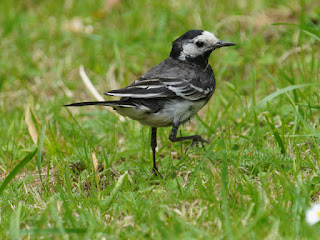The Coal Tit in the Flower Walk ...
... and the one on the far side of the Albert Memorial were both visible today. They are not the same bird, as I thought they might have been.
A young Blue Tit perched in the top of a hawthorn tree near the bridge.
There are families of Reed Warblers all over the place. Ahmet Amerikali got pictures of them below the Italian Garden ...
... and near the bridge ...
... and I got a glimpse of a young one in a tree east of the Lido.
The Pied Wagtail was back near the Dell.
The pair of Jays that follow me down the edge of the Long Water demanding peanuts are a familiar sight, but today they had a young one with them begging for food from its parents.
The newly discovered pigeon-eating Herring Gull had just finished a gory meal and was washing the blood off its face.
The Great Crested Grebe chick from the nest in the willow was under the bridge with a parent.
The teenager was fishing near Peter Pan.
The last surviving Mallard duckling was also here.
The usual pair of Mallards were in the pool at the top of the Dell waterfall. The drake is now in eclipse, looking inconspicuous as he needs to because he has also moulted his flight feathers and would be in greater danger from predators if he looked brighter.
This is a rather slow time for birds, but bees are out in force.
A Patchwork Leaf-Cutter Bee (Megachile centuncularis) browsed on a Knapweed flower. A Honeybee also visited.
The large single Rugosa roses in the Rose Garden, which are particularly liked by bees, are beginning to wither and there is strong competition for the remaining flowers.
Anemones produce the same ecstatic wriggling as bees' favourite roses.
Two hoverflies, a Marmalade Fly Episyrphus balteatus, and an Eristalis tenax, visited Corn Marigolds.











I suppose it must be said to the pair of Jays that follow you around demanding peanuts: "what goes around, comes around". Now they have a begger of their very own on their tails.
ReplyDeleteBoth Coal Tits look very eager to be fed.
Yes, I was amused to see those Jays being given a dose of their own medicine.
DeleteCoal Tits will also follow you for some distance demanding food. Though tiny they have strong characters. Each pine nut is secreted in a crack in a tree for later retrieval.
Royal Parks in the news again. Jim
ReplyDeleteDear oh dear. But pretty much what I would have expected.
DeleteEnjoyed watching the bees in the rose then just over halfway through the distraction of a Harlequin Ladybird larva ravenously wandering over the leaf.
ReplyDeleteThe Eristalis on the Corn Marigold isn't E. tenax. I suspect E. nemorum.
Thanks for the correction, now implemented both on the blog and on YouTube. I find it odd that bees pick their way steadily and carefully over composite flowers but go completely ape on open single flowers like wild-type roses and anemones. Is this really an efficient strategy for picking up pollen?
Delete